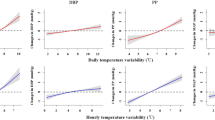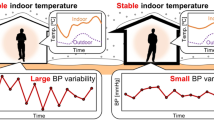Abstract
Blood pressure (BP) is influenced by various factors, and it is known that temperature and BP have a negative relationship. However, few reports have examined the relationship between BP and temperature throughout the day in the same participant over time. Therefore, this study aimed to investigate the relationship between BP and temperature in the morning and evening in the same participants during a time period of ~1 year. In total, 401 participants, who participated in a community-based health checkup survey in Tarumizu, Japan, were enrolled. Five participants were excluded due to missing data. All participants measured their BP and the room temperature at home using a blood pressure monitor (HEM-9700T, OMRON Healthcare, Kyoto, Japan). The mean systolic BP (SBP) and diastolic BP (DBP) in the morning were significantly higher than the mean of the measurements taken in the evening (SBP: morning vs. evening 128 ± 15 mmHg vs. 122 ± 14 mmHg, P < 0.0001; DBP: morning vs. evening 77 ± 10 mmHg vs. 72 ± 8 mmHg, P < 0.0001). Using a linear mixed model with participants as a random effect, SBP and DBP were significantly associated with temperature in both the morning and evening. In the morning, in almost every month except July, a significant association between SBP and temperature was observed. However, there was a significant relationship between evening BP and temperature in all months. In conclusion, BP was significantly related to temperature in both the morning and evening during the year-long study. Furthermore, BP and temperature were significantly associated in all months except morning measurements in July.
This is a preview of subscription content, access via your institution
Access options
Subscribe to this journal
Receive 12 print issues and online access
$259.00 per year
only $21.58 per issue
Buy this article
- Purchase on Springer Link
- Instant access to full article PDF
Prices may be subject to local taxes which are calculated during checkout


Similar content being viewed by others
References
Fujiyoshi A, Ohkubo T, Miura K, Murakami Y, Nagasawa SY, Okamura T, et al. Blood pressure categories and long-term risk of cardiovascular disease according to age group in Japanese men and women. Hypertens Res. 2012;35:947–53.
Imano H, Kitamura A, Sato S, Kiyama M, Ohira T, Yamagishi K, et al. Trends for blood pressure and its contribution to stroke incidence in the middle-aged Japanese population: the Circulatory Risk in Communities Study (CIRCS). Stroke. 2009;40:1571–7.
Takashima N, Ohkubo T, Miura K, Okamura T, Murakami Y, Fujiyoshi A, et al. Long-term risk of BP values above normal for cardiovascular mortality: a 24-year observation of Japanese aged 30 to 92 years. J Hypertens. 2012;30:2299–306.
Imai Y, Obara T, Asamaya K, Ohkubo T. The reason why home blood pressure measurements are preferred over clinic or ambulatory blood pressure in Japan. Hypertens Res. 2013;36:661–72.
Asayama K, Ohkubo T, Metoki H, Obara T, Inoue R, Kikuya M, et al. Cardiovascular outcomes in the first trial of antihypertensive therapy guided by self-measured home blood pressure. Hypertens Res. 2012;35:1102–10.
Noguchi Y, Asayama K, Staessen JA, Inaba M, Ohkubo T, Hosaka M, et al. J Hypertens. 2013;31:1593–602.
Satoh M, Maeda T, Hoshide S, Ohkubo T. Is antihypertensive treatment based on home blood pressure recommended rather than that based on office blood pressure in adults with essential hypertension? (meta-analysis). Hypertens Res. 2019;42:807–16.
Watabe D, Asayama K, Hanazawa T, Hosaka M, Satoh M, Yasui D, et al. Predictive power of home blood pressure indices at baseline and during follow-up in hypertensive patients: HOMED-BP study. Hypertens Res. 2018;41:622–8.
Yu B, Jin S, Wang C, Yan S, Zhou X, Cui X, et al. The association of outdoor temperature with blood pressure, and its influence on future cardio-cerebrovascular disease risk in cold areas. J Hypertens. 2020. https://doi.org/10.1097/HJH.0000000000002387.
Shiue I, Shiue M. Indoor temperature below 18°C accounts for 9% population attributable risk for high blood pressure in Scotland. Int J Cardiol. 2014;171:e1–2.
Tabara Y, Matsumoto T, Murase K, Nagashima S, Hirai T, Kosugi S, et al. Seasonal variation in nocturnal home blood pressure fall: The Nagahama Study. Hypertens Res. 2018;41:198–208.
Wang Q, Li C, Guo Y, Barnett AG, Tong S, Phung D, et al. Environmental ambient temperature and blood pressure in adults: A systematic review and meta-analysis. Sci Total Environ. 2017;575:276–86.
Saeki K, Obayashi K, Iwamoto J, Tone N, Okamoto N, Tomioka K, et al. The relationship between indoor, outdoor and ambient temperatures and morning BP surges from inter-seasonally repeated measurements. J Hum Hypertens. 2014;28:482–88.
Stergiou GS, Myrsilidi A, Kollias A, Destounis A, Roussias L, Kalogeropoulos P. Seasonal variation in meteorological parameters and office, ambulatory and home blood pressure: predicting factors and clinical implications. Hypertens Res. 2015;38:869–75.
Modesti PA, Morabito M, Massetti L, Rapi S, Orlandini S, Mancia G, et al. Seasonal blood pressure changes: an independent relationship with temperature and daylight hours. Hypertension. 2013;61:908–14.
Tu YK, Chien KL, Chiu YW, Ellison GT. Seasonal variation in blood pressure is modulated by gender and age but not by BMI in a large Taiwanese population, 1996–2006. J Am Soc Hypertens. 2013;7:216–28.
Modesti PA, Rapi S, Rogolino A, Tosi B, Galanti G. Seasonal blood pressure variation: implications for cardiovascular risk stratification. Hypertens Res. 2018;41:475–82.
Brennan PJ, Greenberg G, Miall WE, Thompson SG. Seasonal variation in arterial blood pressure. Br Med J. 1982;285:919–23.
Iwahori T, Miura K, Obayashi K, Ohkubo T, Nakajima H, Shiga T, et al. Seasonal variation in home blood pressure: findings from nationwide web-based monitoring in Japan. BMJ Open. 2018;8:e017351.
Sheth T, Nair C, Muller J, Yusuf S. Increased winter mortality from acute myocardial infarction and stroke: the effect of age. J Am Coll Cardiol. 1999;33:1916–9.
The Eurowinter Group. Cold exposure and winter mortality from ischaemic heart disease, cerebrovascular disease, respiratory disease, and all causes in warm and cold regions of Europe. Eurowinter Group Lancet. 1997;349:1341–6.
Saeki K, Obayashi K, Iwamoto J, Tone N, Okamoto N, Tomioka K, et al. Stronger association of indoor temperature than outdoor temperature with blood pressure in colder months. J Hypertens. 2014;32:1582–9.
Barnett AG, Sans S, Salomaa V, Kuulasmaa K, Dobson AJ. WHO MONICA Project. The effect of temperature on systolic blood pressure. Blood Press Monit. 2007;12:195–203.
Acknowledgements
We wish to thank Chikashi Yamaguchi and Kohko Horinouchi of the Kagoshima Heart Club for their help with obtaining BP data measured by the participants. This study was conducted by OMRON HEALTHCARE Co., Ltd. in cooperation with the Department of Cardiovascular Medicine and Hypertension, Graduate School of Medical and Dental Sciences, Kagoshima University. The running cost of this observational study was funded by OMRON Healthcare Co., Ltd.
Author information
Authors and Affiliations
Corresponding author
Ethics declarations
Conflict of interest
TK, AY, and MO received research support from Omron Healthcare Co., Ltd. MK, SF, and KM are employees of OMRON Healthcare Co., Ltd.
Additional information
Publisher’s note Springer Nature remains neutral with regard to jurisdictional claims in published maps and institutional affiliations.
Rights and permissions
About this article
Cite this article
Kubozono, T., Akasaki, Y., Kawasoe, S. et al. The relationship between home blood pressure measurement and room temperature in a Japanese general population. Hypertens Res 44, 454–463 (2021). https://doi.org/10.1038/s41440-020-00564-3
Received:
Revised:
Accepted:
Published:
Issue Date:
DOI: https://doi.org/10.1038/s41440-020-00564-3
Keywords
This article is cited by
-
Associations of indoor and outdoor temperatures and their difference with home blood pressure: The Masuda Study
Hypertension Research (2023)
-
Morning surge in sympathetic nervous activity in the indoor environment during the cold winter season
Hypertension Research (2023)
-
Latest hypertension research to inform clinical practice in Asia
Hypertension Research (2022)
-
Impact of indoor temperature instability on diurnal and day-by-day variability of home blood pressure in winter: a nationwide Smart Wellness Housing survey in Japan
Hypertension Research (2021)



